Formula C23H22O6 Melting point 165 °C Boiling point 210 °C | Molar mass 394.41 g/mol Density 1.27 g/cm³ | |
 | ||
Appearance Colorless to red crystalline solid IUPAC ID (2R,6aS,12aS)-1,2,6,6a,12,12a- hexahydro-2-isopropenyl-8,9- dimethoxychromeno[3,4-b] furo(2,3-h)chromen-6-one | ||
Rotenone is an odorless, colorless, crystalline isoflavone used as a broad-spectrum insecticide, piscicide, and pesticide. It occurs naturally in the seeds and stems of several plants, such as the jicama vine plant, and the roots of several members of Fabaceae. It was the first described member of the family of chemical compounds known as rotenoids.
Contents
- Discovery
- Uses
- Mechanism of action
- Presence in plants
- Toxicity
- Parkinsons disease
- Notable administrations
- Deactivation
- References

Discovery
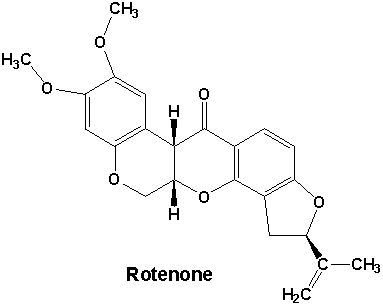
The earliest record of the now-known rotenone-containing plants used for killing leaf-eating caterpillars was in 1848, and for centuries, the same plants were used to poison fish. The active chemical component was first isolated in 1895 by a French botanist, Emmanuel Geoffroy, who called it nicouline, from a specimen of Robinia nicou, now called Lonchocarpus nicou, while traveling in French Guiana. He wrote about this research in his thesis, published posthumously in 1895 after his death from a parasitic disease. In 1902 Japanese chemist Nagai Nagayoshi isolated a pure crystalline compound from Derris elliptica which he called rotenone, after the Japanese name of the plant, roten. By 1930, nicouline and rotenone were established to be chemically the same.
Uses
Rotenone is used as a pesticide, insecticide, and as a nonselective piscicide (fish killer).
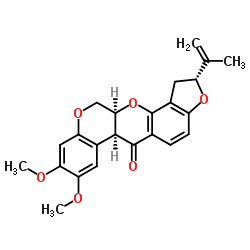
It is commercialized as cubé, tuba, or derris, in single preparation or in synergistic combination with other insecticides. In the United States and Canada, all uses of rotenone except as a piscicide are being phased out.
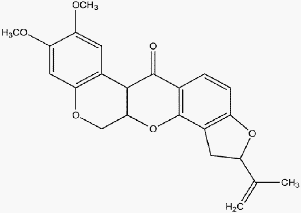
Rotenone has historically been used by indigenous peoples to catch fish. Typically, rotenone-containing plants in the Fabaceae family of legumes are crushed and introduced into a body of water, and as rotenone interferes with cellular respiration, the affected fish rise to the surface in an attempt to gulp air, where they are more easily caught.
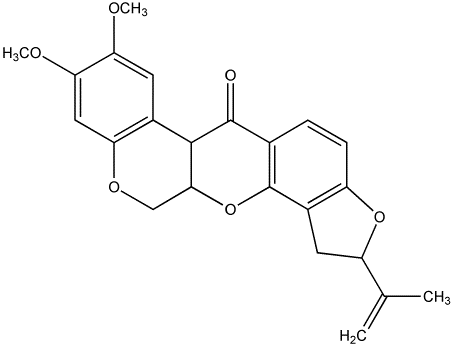
Rotenone has been used by government agencies to kill fish in rivers and lakes in the United States since 1952.
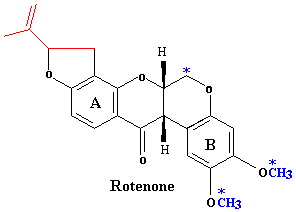
Small-scale sampling with rotenone is used by fish researchers studying the biodiversity of marine fishes to collect cryptic, or hidden, fishes, which represent an important component of shoreline fish communities. Rotenone is the most effective tool available because only small quantities are necessary. It has only minor and transient environmental side effects.
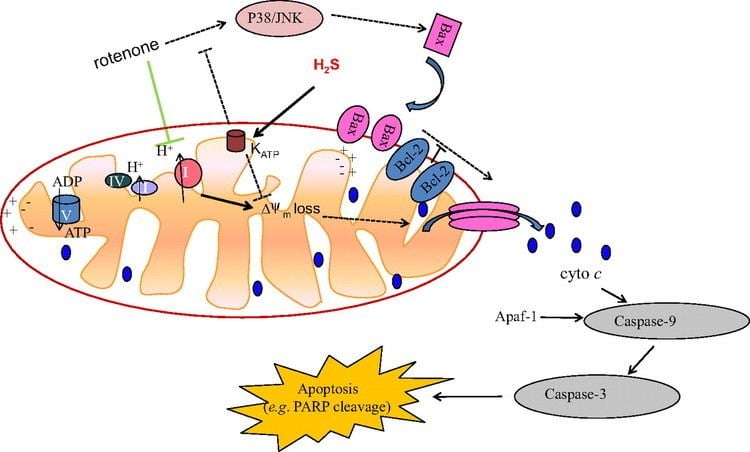
Rotenone is also used in powdered form to treat scabies and head lice on humans, and parasitic mites on chickens, livestock, and pet animals.
Rotenone has been used as an organic pesticide dust for gardens. Unselective in action, it kills potato beetles, cucumber beetles, flea beetles, cabbage worms, raspberry beetles, and asparagus beetles, as well as most other arthropods. It rapidly biodegrades under warm conditions, so harmful residues are minimal. A light dusting on the leaves of plants will control insects for several days.
Mechanism of action
Rotenone works by interfering with the electron transport chain in mitochondria. It inhibits the transfer of electrons from iron-sulfur centers in complex I to ubiquinone. This interferes with NADH during the creation of usable cellular energy (ATP). Complex I is unable to pass off its electron to CoQ, creating a back-up of electrons within the mitochondrial matrix. Cellular oxygen is reduced to the radical, creating a reactive oxygen species, which can damage DNA and other components of the mitochondria.
Presence in plants
Rotenone is produced by extraction from the roots and stems of several tropical and subtropical plant species, especially those belonging to the genera Lonchocarpus and Derris.
Some of the plants containing rotenone:
Toxicity
Rotenone is classified by the World Health Organization as moderately hazardous. It is mildly toxic to humans and other mammals, but extremely toxic to insects and aquatic life, including fish. This higher toxicity in fish and insects is because the lipophilic rotenone is easily taken up through the gills or trachea, but not as easily through the skin or the gastrointestinal tract. Rotenone is toxic to erythrocytes in vitro.
The lowest lethal dose for a child is 143 mg/kg. Human deaths from rotenone poisoning are rare because its irritating action causes vomiting. Deliberate ingestion of rotenone can be fatal.
The compound decomposes when exposed to sunlight and usually has an activity of six days in the environment. It oxidizes to rotenolone, which is about an order of magnitude less toxic than rotenone. In water, the rate of decomposition depends upon several factors, including temperature, pH, water hardness and sunlight. The half-life in natural waters ranges from half a day at 24 °C to 3.5 days at 0 °C.
Parkinson's disease
In 2000, injecting rotenone into rats was reported to cause the development of symptoms similar to those of Parkinson's disease (PD). Rotenone was continuously applied over a period of five weeks, mixed with DMSO and PEG to enhance tissue penetration, and injected into the jugular vein. The study does not directly suggest rotenone exposure is responsible for PD in humans, but is consistent with the belief that chronic exposure to environmental toxins increases the likelihood of the disease.
In addition, studies with primary cultures of rat neurons and microglia have shown low doses of rotenone (below 10 nM) induce oxidative damage and death of dopaminergic neurons, and it is these neurons in the substantia nigra that die in Parkinson's disease. Another study has also described toxic action of rotenone at low concentrations (5 nM) in dopaminergic neurons from acute rat brain slices. This toxicity was exacerbated by an additional cell stressor – elevated intracellular calcium concentration – adding support to the 'multiple hit hypothesis' of dopaminergic neuron death.
The neurotoxin MPTP had been known earlier to cause PD-like symptoms (in humans and other primates, though not in rats) by interfering with complex I in the electron transport chain and killing dopaminergic neurons in the substantia nigra. However, further studies involving MPTP have failed to show development of Lewy bodies, a key component to PD pathology. Therefore, the mechanism behind MPTP as it relates to Parkinson's disease is not fully understood. Because of these developments, rotenone was investigated as a possible Parkinson-causing agent. Both MPTP and rotenone are lipophilic and can cross the blood–brain barrier.
In 2010, a study was published detailing the progression of Parkinson's-like symptoms in mice following chronic intragastric ingestion of low doses of rotenone. The concentrations in the central nervous system were below detectable limits, yet still induced PD pathology.
In 2011, a US National Institutes of Health study showed a link between rotenone use and Parkinson's disease in farm workers.
Notable administrations
Rotenone was implemented in 2010 to kill an invasive goldfish population present in Mann Lake, with the intention of not disrupting the lake's trout population. Rotenone successfully achieved these aims, killing nearly 200,000 goldfish, and only three trout.
Beginning May 1, 2006, Panguitch Lake was treated with rotenone, to potentially eradicate and control the invasive population of Utah chub. which were probably introduced accidentally by anglers who used them as live bait. The lake was restocked with 20,000 rainbow trout in 2006; as of 2016, the lake's fish population has recovered.
In 2014, Rotenone was used to kill all remaining fish in San Francisco's Mountain Lake, which is located in Mountain Lake Park in order to rid it of invasive species introduced since the migration of European settlers to the region.
Rotenon is used in biomedical research to study oxygen consumption rate of cells usually in combination with antimycin-D (an electron transport chain Complex III inhibitor).
Deactivation
Rotenone can be deactivated in water with the use of Potassium Permanganate to lower toxicity back down to acceptable levels.
